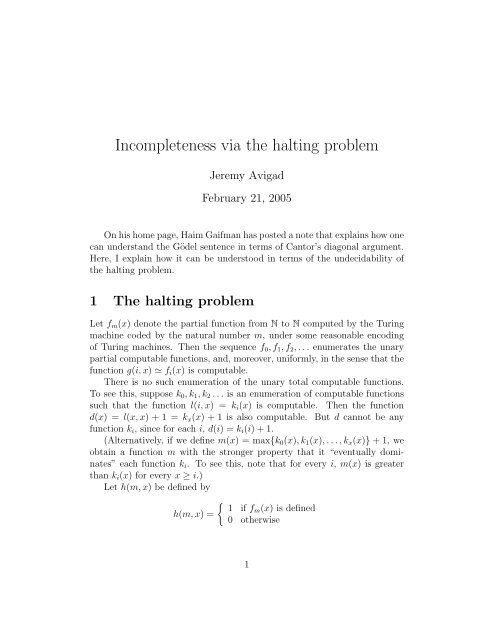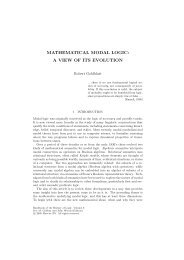Incompleteness via the halting problem
Incompleteness via the halting problem
Incompleteness via the halting problem
Create successful ePaper yourself
Turn your PDF publications into a flip-book with our unique Google optimized e-Paper software.
<strong>Incompleteness</strong> <strong>via</strong> <strong>the</strong> <strong>halting</strong> <strong>problem</strong>Jeremy AvigadFebruary 21, 2005On his home page, Haim Gaifman has posted a note that explains how onecan understand <strong>the</strong> Gödel sentence in terms of Cantor’s diagonal argument.Here, I explain how it can be understood in terms of <strong>the</strong> undecidability of<strong>the</strong> <strong>halting</strong> <strong>problem</strong>.1 The <strong>halting</strong> <strong>problem</strong>Let f m (x) denote <strong>the</strong> partial function from N to N computed by <strong>the</strong> Turingmachine coded by <strong>the</strong> natural number m, under some reasonable encodingof Turing machines. Then <strong>the</strong> sequence f 0 , f 1 , f 2 , . . . enumerates <strong>the</strong> unarypartial computable functions, and, moreover, uniformly, in <strong>the</strong> sense that <strong>the</strong>function g(i, x) ≃ f i (x) is computable.There is no such enumeration of <strong>the</strong> unary total computable functions.To see this, suppose k 0 , k 1 , k 2 . . . is an enumeration of computable functionssuch that <strong>the</strong> function l(i, x) = k i (x) is computable. Then <strong>the</strong> functiond(x) = l(x, x) + 1 = k x (x) + 1 is also computable. But d cannot be anyfunction k i , since for each i, d(i) = k i (i) + 1.(Alternatively, if we define m(x) = max{k 0 (x), k 1 (x), . . . , k x (x)} + 1, weobtain a function m with <strong>the</strong> stronger property that it “eventually dominates”each function k i . To see this, note that for every i, m(x) is greaterthan k i (x) for every x ≥ i.)Let h(m, x) be defined by{ 1 if fm (x) is definedh(m, x) =0 o<strong>the</strong>rwise1
The function h(m, x) is a version of <strong>the</strong> “<strong>halting</strong> <strong>problem</strong>,” since it amountsto a decision, for each m and x, as to whe<strong>the</strong>r Turing machine m halts oninput x.The simple diagonalization above gives us an indirect way of seeing that<strong>the</strong> <strong>halting</strong> <strong>problem</strong> is unsolvable, i.e. that h is not computable. For, if hwere computable, we could compute{fm (x) if h(m, x) = 1l(m, x) =0 o<strong>the</strong>rwiseDefining k i (x) = l(i, x) would <strong>the</strong>n yield an enumeration of all <strong>the</strong> totalcomputable functions, and we have showed that this is impossible.One can prove that h is not computable more directly. Suppose h werecomputable. Then we could define a a partial function s(x) by{ 0 if h(x, x) = 1s(x) ≃undefined o<strong>the</strong>rwiseBy our hypo<strong>the</strong>sis, s(x) is a partial computable function. Let m be suchthat s = f m . Then s(m) is defined, by definition, if and only if h(m, m) = 0;but by <strong>the</strong> definition of h, this happens if and only if f m (m), i.e. s(m), isundefined.2 Provably total computable functionsIn <strong>the</strong>se notes, we will be interested in effectively axiomatized <strong>the</strong>ories of“interpret a reasonable amount of arithmetic.” In particular, if a consistent<strong>the</strong>ory T interprets Robinson’s <strong>the</strong>ory Q, <strong>the</strong>n it can represent <strong>the</strong> notions is a <strong>halting</strong> computation sequence for Turing machine m startingwith input xin such a way that for every m, x, and s, s really is a <strong>halting</strong> computationsequence for machine m on input x if and only if T proves that this is <strong>the</strong>case.Such a <strong>the</strong>ory T is said to be Π 2 -sound if <strong>the</strong> following holds:For every m, T proves “for every x, machine m halts on input x”if and only if for every x, machine m halts on input x.2
A computable function f from <strong>the</strong> natural numbers to <strong>the</strong> natural numbers issaid to be provably total in a <strong>the</strong>ory T if <strong>the</strong>re is some machine, m, computingf such that T proves “for every x, machine m halts on input x.” Saying thatT is Π 2 -sound simply amounts to <strong>the</strong> assertion that whenever T proves astatement of this form, <strong>the</strong>n machine m really computes a total function.There is a natural way of enumerating all <strong>the</strong> provably total computablefunctions of such a <strong>the</strong>ory: for each i, if i describes a proof of <strong>the</strong> statement“for every x, machine m halts on input x” for some i, let k i be <strong>the</strong> functioncomputed by machine m; o<strong>the</strong>rwise, let k i be <strong>the</strong> constant zero function.Assuming T is effectively axiomatized, this enumeration is uniform, in<strong>the</strong> sense that for every i and x we can compute l(i, x) = k i (x). But we knowfrom <strong>the</strong> preceeding section that <strong>the</strong> sequence k 0 , k 1 , k 2 , . . . cannot enumerateall <strong>the</strong> computable functions. This means that <strong>the</strong>re must be a computablefunction s that is not on <strong>the</strong> list. If m is any Turing machine that computess, <strong>the</strong>n m halts on every input, but T does not prove that m halts on everyinput. Thus we have shown that <strong>the</strong>re is a true sentence that cannot beproved in T .In fact, Gödel’s notion of ω-consistency implies Π 2 -soundness. For <strong>the</strong>Turing machine m described in <strong>the</strong> preceding paragraph, it also implies thatT does not prove (falsely) that m doesn’t halt on some input, since for eachparticular input, T can verify that machine m really does halt. Thus we haveshown:Theorem 2.1 Let T be an ω-consistent, effectively axiomatized <strong>the</strong>ory interpretingQ. Then <strong>the</strong>re is a sentence ϕ that is nei<strong>the</strong>r provable nor refutablein T .This is a weak version of first incompleteness <strong>the</strong>orem.It is instructive to spell out <strong>the</strong> argument in greater detail. For each i, letk i be <strong>the</strong> ith provably total computable function in T . Let s(x) = k x (x) + 1.We have argued that:1. s(x) is a total computable function (since T is effectively axiomatized,and Π 2 -sound), but2. T doesn’t prove s(x) is total (by <strong>the</strong> diagonal argument).Why is it that we can prove that s(x) is total, but T can’t? The answer isthat we have made central use of <strong>the</strong> fact that T is Π 2 -sound. With slightlystronger assumptions on <strong>the</strong> amount of arithmetic one can develop in T , thisargument can formalized. Thus, we have shown:3
Theorem 2.2 Let T be as above, and assume T interprets a sufficient amountof arithmetic. Then T does not prove its Π 2 -soundness.This is a weak version of <strong>the</strong> second incompleteness <strong>the</strong>orem.3 The incompleteness <strong>the</strong>oremsWe can obtain better versions of <strong>the</strong> incompleteness <strong>the</strong>orems using <strong>the</strong> moredirect proof of <strong>the</strong> unsolvability of <strong>the</strong> <strong>halting</strong> <strong>problem</strong> described in Section 1.Given an effectively axiomatized <strong>the</strong>ory T , consider <strong>the</strong> following attempt tosolve <strong>the</strong> <strong>halting</strong> <strong>problem</strong>: on input m and x, simultaneously do <strong>the</strong> following:1. simulate Turing machine m on input x, to see if it halts; and2. search for a proof in T that m doesn’t halt on input x.In <strong>the</strong> first case, output 1 (“yes”), and in <strong>the</strong> second case, output 0 (“no”).Clearly any “yes” answer is a correct answer to <strong>the</strong> <strong>halting</strong> <strong>problem</strong>.Assuming T is consistent, every “no” answer has to be correct as well. Butwe know that <strong>the</strong> <strong>halting</strong> <strong>problem</strong> is unsolvable, which means that somethinghas to go wrong. The only thing that can possibly go wrong is that <strong>the</strong>remay be a Turing machine m and an input x, such that m does not halt oninput x, but T does not prove this fact. The unsolvability of <strong>the</strong> <strong>halting</strong><strong>problem</strong> implies that this is, indeed, <strong>the</strong> case.On <strong>the</strong> o<strong>the</strong>r hand, assuming T is ω-consistent, for m and x as above, Tcannot prove (falsely) that m does halt on input x, since for each particulars it can verify that s is not a <strong>halting</strong> computation sequence. Letting ϕ be <strong>the</strong>sentence “machine m does not halt on input x,” we have shown <strong>the</strong> following:Theorem 3.1 Let T be an effectively axiomatized <strong>the</strong>ory interpreting Q.Then <strong>the</strong>re is an assertion ϕ such that if T is consistent, it does not proveϕ, and if T is ω-consistent, it does not prove ¬ϕ.This is essentially Gödel’s version of <strong>the</strong> first incompleteness <strong>the</strong>orem. It isstronger than Theorem 2.1 since for one part of <strong>the</strong> independence we onlyneed to assume <strong>the</strong> consistency of T .Again, it is instructive to unwrap <strong>the</strong> argument and make it more direct.For each x, let ψ(x) be <strong>the</strong> assertion that Turing machine x does not halt oninput x. Let m be a Turing machine that, on input x, searches for a proofof ψ(x) in T , and halts if it finds one.4
Assuming T is consistent, it does not prove ψ(m), that is, <strong>the</strong> assertionthat machine m does not halt on input m. For, if <strong>the</strong>re is such a proof, <strong>the</strong>nmachine m does halt on input m, and this fact is also provable in T , makingT inconsistent.Assuming T is ω-consistent, it does not prove ¬ψ(m), that is, <strong>the</strong> assertionthat m does halt on input m. For, we have just shown that m does not halton input m, and T can <strong>the</strong>refore verify, for each s, that s is not a <strong>halting</strong>computation sequence.The statement ψ(m), that is, <strong>the</strong> assertion that m does not halt on inputm, is a version of <strong>the</strong> Gödel sentence. The original Gödel sentence asserted “Iam not provable”; this one asserts that “<strong>the</strong> algorithm searching for a proofof me doesn’t halt.” The only difference is that <strong>the</strong> first is cast in terms ofproofs, and <strong>the</strong> second is cast in terms of algorithms. Both arguments relyon <strong>the</strong> relationship between provability and computability.Note that we have described a Turing machine m such that1. m does not halt on input m, but2. assuming T is consistent, T does not prove that m does not halt oninput m.With appropriate restrictions on T , T can carry out <strong>the</strong>se arguments. Sinceit can also show that <strong>the</strong> conlusion of T implies 1, we have:Theorem 3.2 Assuming T is consistent, effectively axiomatized, and interpretsa sufficient amount of arithmetic, T does not prove its own consistency.This is <strong>the</strong> second incompleteness <strong>the</strong>orem.One can tell a similar story to explain Rosser’s streng<strong>the</strong>ning of <strong>the</strong> firstincompleteness <strong>the</strong>orem, which lifts <strong>the</strong> assumption of ω-consistency.5
















